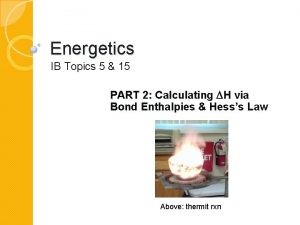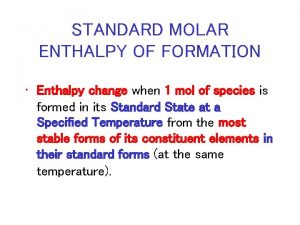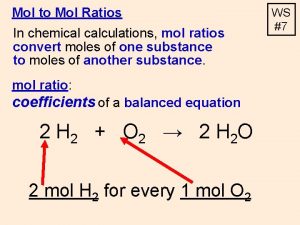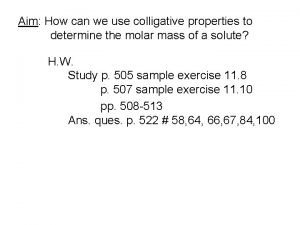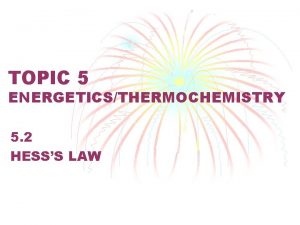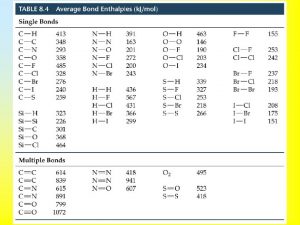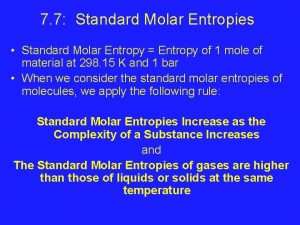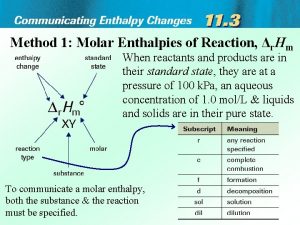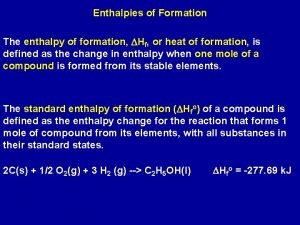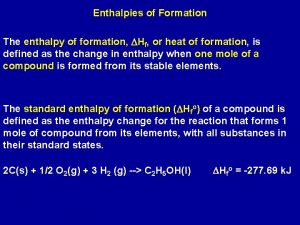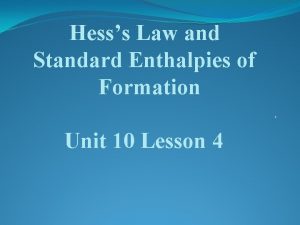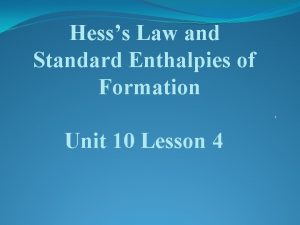Using Standard Molar Enthalpies of Formation SCH 4













- Slides: 13

Using Standard Molar Enthalpies of Formation SCH 4 U 0 Mr. Krstovic

Focus Questions n n n 1) What are formation reactions? 2) What is standard molar enthalpy of formation? 3) How do we write a formation equation? 4) How do we calculate the ∆H using the standard molar enthalpy of formations? 5) How does this method relate to Hess’s Law?

Formation Reactions n n In a formation reaction, a substance is formed from elements in their standard states From what elements is water formed? H 2(g) + ½O 2 (g) H 2 O (l) ΔHfo = -285. 8 k. J The enthalpy change of a formation reaction is called the standard molar enthalpy of formation, ∆H˚f.

Definition of ∆H˚f n The standard molar enthalpy of formation is the quantity of energy that is absorbed or released when one mole of a compound is formed directly from its elements in their standard states.

Formation Equations and ∆H˚f

Note n n The standard enthalpies of formation of most compounds are negative. By definition, the enthalpy of formation of an element in its standard state is zero

Writing a formation equation n n Always write the elements in their standard state (l, g, or s). A formation equation should also show the formation of exactly one mole of the compound of interest.

Calculating Enthalpy Changes n n You can calculate the enthalpy change of a chemical reaction by adding the heats of formation of the products and subtracting the heats of formation of the reactants. ∆H˚ = Σ(n∆H˚f products) - Σ(n∆H˚f reactants)

Note n n As usual, you need to begin with a balanced chemical equation. If a given reactant or product has a molar coefficient that is not 1, you need to multiply its ∆H˚f by the same molar coefficient.


How does this method of adding heats of formation relate to Hess’s law?

Note n n It is important to realize that, in most reactions, the reactants do not actually break down into their elements and then react to form products. Since there is extensive data about enthalpies of formation, however, it is useful to calculate the overall enthalpy change this way.

Homework Questions n n n p. 332 # 1 p. 335 # 2 -5 p. 339 # 1, 2
 Bond enthalpy reactants minus products
Bond enthalpy reactants minus products Limitations of average bond enthalpies
Limitations of average bond enthalpies How to calculate enthalpy change
How to calculate enthalpy change Viewgrade 5 sch
Viewgrade 5 sch Formation initiale vs formation continue
Formation initiale vs formation continue How to calculate grams to moles
How to calculate grams to moles Calculating molar mass using colligative properties
Calculating molar mass using colligative properties Application of hess law
Application of hess law Q=mc∆t
Q=mc∆t Standard error of the mean
Standard error of the mean Standard language meaning
Standard language meaning Standerd costing
Standerd costing Bahagian pembangunan kurikulum dskp
Bahagian pembangunan kurikulum dskp A standard normal table
A standard normal table

